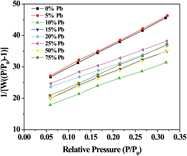Crossref Citations
This article has been cited by the following publications. This list is generated based on data provided by
Crossref.
Ahmad, Tokeer
Khatoon, Sarvari
and
Phul, Ruby
2013.
A Review on Chemical Synthesis, Characterization and Optical Properties of Nanocrystalline Transition Metal Doped Dilute Magnetic Semiconductors.
Solid State Phenomena,
Vol. 201,
Issue. ,
p.
103.
Al-Hartomy, Omar A.
Ubaidullah, Mohd
Kumar, Dinesh
Madani, Jamal H.
and
Ahmad, Tokeer
2013.
Dielectric properties of Ba1-xSrxZrO3 (0 ≤ x ≤ 1) nanoceramics developed by citrate precursor route.
Journal of Materials Research,
Vol. 28,
Issue. 8,
p.
1070.
Ahmad, Tokeer
Wani, Irshad A.
Ahmed, Jahangeer
and
Al-Hartomy, Omar A.
2014.
Effect of gold ion concentration on size and properties of gold nanoparticles in TritonX-100 based inverse microemulsions.
Applied Nanoscience,
Vol. 4,
Issue. 4,
p.
491.
Ahmad, Tokeer
Wani, Irshad A.
Al-Hartomy, Omar A.
Al-Shihri, Ayed S.
and
Kalam, Abul
2015.
Low temperature chemical synthesis and comparative studies of silver oxide nanoparticles.
Journal of Molecular Structure,
Vol. 1084,
Issue. ,
p.
9.
Ahmad, Tokeer
and
Phul, Ruby
2015.
Magnetic Iron Oxide Nanoparticles as Contrast Agents: Hydrothermal Synthesis, Characterization and Properties.
Solid State Phenomena,
Vol. 232,
Issue. ,
p.
111.
Ahmad, Tokeer
2017.
Hydrothermal Synthesis, Characterization and Dielectric Properties of Zirconia Nanoparticles.
Material Science & Engineering International Journal,
Vol. 1,
Issue. 3,
Ahmad, Tokeer
Ubaidullah, Mohd
Lone, Irfan H.
Kumar, Dinesh
and
Al-Hartomy, Omar A.
2017.
Microemulsion synthesis, structural characterization and dielectric properties of Ba 1-x Pb x ZrO 3 (0.05 ≤ x ≤ 0.20) nanoparticles.
Materials Research Bulletin,
Vol. 89,
Issue. ,
p.
185.
Ahmad, Tokeer
Ubaidullah, Mohd
Shahazad, Mohd
Kumar, Dinesh
and
Al-Hartomy, Omar A.
2017.
Reverse micellar synthesis, structural characterization and dielectric properties of Sr-doped BaZrO3 nanoparticles.
Materials Chemistry and Physics,
Vol. 185,
Issue. ,
p.
31.
Ahmad, Tokeer
Lone, Irfan H.
Ansari, S.G.
Ahmed, Jahangeer
Ahamad, Tansir
and
Alshehri, Saad M.
2017.
Multifunctional properties and applications of yttrium ferrite nanoparticles prepared by citrate precursor route.
Materials & Design,
Vol. 126,
Issue. ,
p.
331.
Lone, Irfan H.
Aslam, Jeenat
Radwan, Nagi R.E.
Akhter, Arifa
Bashal, Ali H.
and
Shiekh, Rayees A.
2020.
Review on Polymeric Citrate Precursor and Sono-chemical Methods for the Synthesis of Nanomaterials.
Current Analytical Chemistry,
Vol. 16,
Issue. 7,
p.
826.
Ubaidullah, Mohd
Ahmed, Jahangeer
Al-Enizi, Abdullah M.
Tyagi, Akshi
Shaikh, Shoyebmohamed F.
Tarannum, Nazia
and
Ahmad, Tokeer
2020.
Metal organic precursor derived Ba1-xCaxZrO3 (0.05 ≤ x ≤ 0.20) nanoceramics for excellent capacitor applications.
Journal of King Saud University - Science,
Vol. 32,
Issue. 3,
p.
1937.
Khirade, Pankaj P.
Raut, A.V.
Alange, R.C.
Barde, W.S.
and
Chavan, Apparao R.
2021.
Structural, electrical and dielectric investigations of cerium doped barium zirconate (BaZrO3) nano-ceramics produced via green synthesis: Probable candidate for solid oxide fuel cells and microwave applications.
Physica B: Condensed Matter,
Vol. 613,
Issue. ,
p.
412948.
Wang, Siyu
Yan, Huimin
Zhao, Donghui
Tan, Zhicheng
and
Shi, Quan
2021.
Low temperature heat capacity and thermodynamic function of BaZrO3 and PbZrO3.
The Journal of Chemical Thermodynamics,
Vol. 158,
Issue. ,
p.
106449.
Ubaidullah, Mohd
Fazil, Mohd
and
Ahmad, Tokeer
2022.
Short review on fabrication, structural and dielectric characterization of zirconium based oxide nanoparticles.
Material Science & Engineering International Journal,
Vol. 6,
Issue. 4,
p.
152.
López-Esquivel, R.I.
Guzmán-Olguín, J.C.
Vázquez-Flores, N.
Correcher, V.
Benavente, J.F.
Guzmán-Mendoza, J.
and
Rivera Montalvo, T.
2023.
Green synthesis, structural and luminescent characterization of BaZrO3:Eu3+ nanoparticles.
Ceramics International,
Vol. 49,
Issue. 1,
p.
413.





